Hongbin Li
IEEE
Dynamic Precoding for Near-Field Secure Communications: Implementation and Performance Analysis
May 08, 2025Abstract:The increase in antenna apertures and transmission frequencies in next-generation wireless networks is catalyzing advancements in near-field communications (NFC). In this paper, we investigate secure transmission in near-field multi-user multiple-input single-output (MU-MISO) scenarios. Specifically, with the advent of extremely large-scale antenna arrays (ELAA) applied in the NFC regime, the spatial degrees of freedom in the channel matrix are significantly enhanced. This creates an expanded null space that can be exploited for designing secure communication schemes. Motivated by this observation, we propose a near-field dynamic hybrid beamforming architecture incorporating artificial noise, which effectively disrupts eavesdroppers at any undesired positions, even in the absence of their channel state information (CSI). Furthermore, we comprehensively analyze the dynamic precoder's performance in terms of the average signal-to-interference-plus-noise ratio, achievable rate, secrecy capacity, secrecy outage probability, and the size of the secrecy zone. In contrast to far-field secure transmission techniques that only enhance security in the angular dimension, the proposed algorithm exploits the unique properties of spherical wave characteristics in NFC to achieve secure transmission in both the angular and distance dimensions. Remarkably, the proposed algorithm is applicable to arbitrary modulation types and array configurations. Numerical results demonstrate that the proposed method achieves approximately 20\% higher rate capacity compared to zero-forcing and the weighted minimum mean squared error precoders.
Weighted Codebook Scheme for RIS-Assisted Point-to-Point MIMO Communications
Mar 10, 2025Abstract:Reconfigurable intelligent surfaces (RIS) can reshape the characteristics of wireless channels by intelligently regulating the phase shifts of reflecting elements. Recently, various codebook schemes have been utilized to optimize the reflection coefficients (RCs); however, the selection of the optimal codeword is usually obtained by evaluating a metric of interest. In this letter, we propose a novel weighted design on the discrete Fourier transform (DFT) codebook to obtain the optimal RCs for RIS-assisted point-to-point multiple-input multiple-output (MIMO) systems. Specifically, we first introduce a channel training protocol where we configure the RIS RCs using the DFT codebook to obtain a set of observations through the uplink training process. Secondly, based on these observed samples, the Lagrange multiplier method is utilized to optimize the weights in an iterative manner, which could result in a higher channel capacity for assisting in the downlink data transmission. Thirdly, we investigate the effect of different codeword configuration orders on system performance and design an efficient codeword configuration method based on statistical channel state information (CSI). Finally, numerical simulations are provided to demonstrate the performance of the proposed scheme.
Multi-bit Distributed Detection of Sparse Stochastic Signals over Error-Prone Reporting Channels
Nov 06, 2024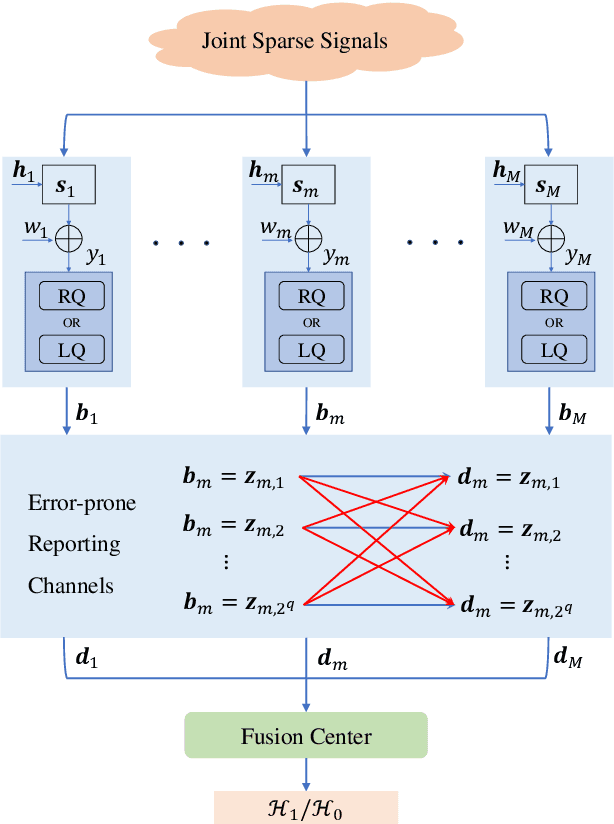

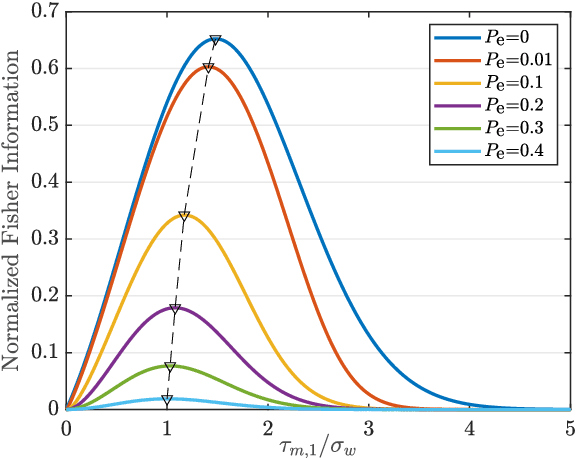
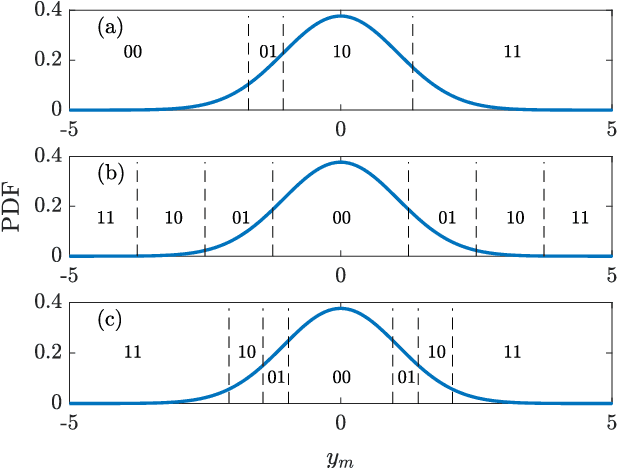
Abstract:We consider a distributed detection problem within a wireless sensor network (WSN), where a substantial number of sensors cooperate to detect the existence of sparse stochastic signals. To achieve a trade-off between detection performance and system constraints, multi-bit quantizers are employed at local sensors. Then, two quantization strategies, namely raw quantization (RQ) and likelihood ratio quantization (LQ), are examined. The multi-bit quantized signals undergo encoding into binary codewords and are subsequently transmitted to the fusion center via error-prone reporting channels. Upon exploiting the locally most powerful test (LMPT) strategy, we devise two multi-bit LMPT detectors in which quantized raw observations and local likelihood ratios are fused respectively. Moreover, the asymptotic detection performance of the proposed quantized detectors is analyzed, and closed-form expressions for the detection and false alarm probabilities are derived. Furthermore, the multi-bit quantizer design criterion, considering both RQ and LQ, is then proposed to achieve near-optimal asymptotic performance for our proposed detectors. The normalized Fisher information and asymptotic relative efficiency are derived, serving as tools to analyze and compensate for the loss of information introduced by the quantization. Simulation results validate the effectiveness of the proposed detectors, especially in scenarios with low signal-to-noise ratios and poor channel conditions.
Line Spectral Estimation with Unlimited Sensing
Aug 13, 2024



Abstract:In the paper, we consider the line spectral estimation problem in an unlimited sensing framework (USF), where a modulo analog-to-digital converter (ADC) is employed to fold the input signal back into a bounded interval before quantization. Such an operation is mathematically equivalent to taking the modulo of the input signal with respect to the interval. To overcome the noise sensitivity of higher-order difference-based methods, we explore the properties of the first-order difference of modulo samples, and develop two line spectral estimation algorithms based on first-order difference, which are robust against noise. Specifically, we show that, with a high probability, the first-order difference of the original samples is equivalent to that of the modulo samples. By utilizing this property, line spectral estimation is solved via a robust sparse signal recovery approach. The second algorithms is built on our finding that, with a sufficiently high sampling rate, the first-order difference of the original samples can be decomposed as a sum of the first-order difference of the modulo samples and a sequence whose elements are confined to be three possible values. This decomposition enables us to formulate the line spectral estimation problem as a mixed integer linear program that can be efficiently solved. Simulation results show that both proposed methods are robust against noise and achieve a significant performance improvement over the higher-order difference-based method.
CSI-Free Position Optimization for Movable Antenna Communication Systems: A Black-Box Optimization Approach
Aug 09, 2024


Abstract:Movable antenna (MA) is a new technology which leverages local movement of antennas to improve channel qualities and enhance the communication performance. Nevertheless, to fully realize the potential of MA systems, complete channel state information (CSI) between the transmitter-MA and the receiver-MA is required, which involves estimating a large number of channel parameters and incurs an excessive amount of training overhead. To address this challenge, in this paper, we propose a CSI-free MA position optimization method. The basic idea is to treat position optimization as a black-box optimization problem and calculate the gradient of the unknown objective function using zeroth-order (ZO) gradient approximation techniques. Simulation results show that the proposed ZO-based method, through adaptively adjusting the position of the MA, can achieve a favorable signal-to-noise-ratio (SNR) using a smaller number of position measurements than the CSI-based approach. Such a merit makes the proposed algorithm more adaptable to fast-changing propagation channels.
Intelligent Reflecting Surface-Assisted NLOS Sensing With OFDM Signals
Jul 02, 2024



Abstract:This work addresses the problem of intelligent reflecting surface (IRS) assisted target sensing in a non-line-of-sight (NLOS) scenario, where an IRS is employed to facilitate the radar/access point (AP) to sense the targets when the line-of-sight (LOS) path between the AP and the target is blocked by obstacles. To sense the targets, the AP transmits a train of uniformly-spaced orthogonal frequency division multiplexing (OFDM) pulses, and then perceives the targets based on the echoes from the AP-IRS-targets-IRS-AP channel. To resolve an inherent scaling ambiguity associated with IRS-assisted NLOS sensing, we propose a two-phase sensing scheme by exploiting the diversity in the illumination pattern of the IRS across two different phases. Specifically, the received echo signals from the two phases are formulated as third-order tensors. Then a canonical polyadic (CP) decomposition-based method is developed to estimate each target's parameters including the direction of arrival (DOA), Doppler shift and time delay. Our analysis reveals that the proposed method achieves reliable NLOS sensing using a modest quantity of pulse/subcarrier resources. Simulation results are provided to show the effectiveness of the proposed method under the challenging scenario where the degrees-of-freedom provided by the AP-IRS channel are not enough for resolving the scaling ambiguity.
Near/Far-Field Channel Estimation For Terahertz Systems With ELAAs: A Block-Sparse-Aware Approach
Apr 08, 2024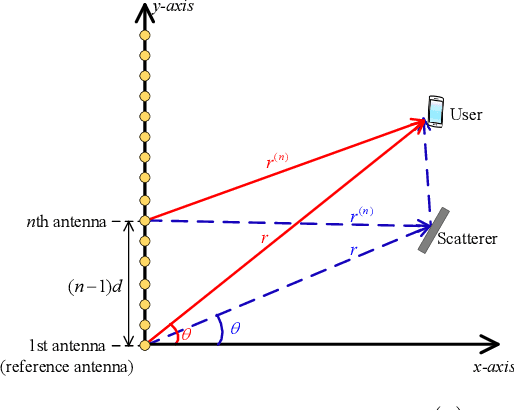



Abstract:Millimeter wave/Terahertz (mmWave/THz) communication with extremely large-scale antenna arrays (ELAAs) offers a promising solution to meet the escalating demand for high data rates in next-generation communications. A large array aperture, along with the ever increasing carrier frequency within the mmWave/THz bands, leads to a large Rayleigh distance. As a result, the traditional plane-wave assumption may not hold valid for mmWave/THz systems featuring ELAAs. In this paper, we consider the problem of hybrid near/far-field channel estimation by taking spherical wave propagation into account. By analyzing the coherence properties of any two near-field steering vectors, we prove that the hybrid near/far-field channel admits a block-sparse representation on a specially designed orthogonal dictionary. Specifically, the percentage of nonzero elements of such a block-sparse representation decreases in the order of $1/\sqrt{N}$, which tends to zero as the number of antennas, $N$, grows. Such a block-sparse representation allows to convert channel estimation into a block-sparse signal recovery problem. Simulation results are provided to verify our theoretical results and illustrate the performance of the proposed channel estimation approach in comparison with existing state-of-the-art methods.
Communication Efficient ConFederated Learning: An Event-Triggered SAGA Approach
Feb 28, 2024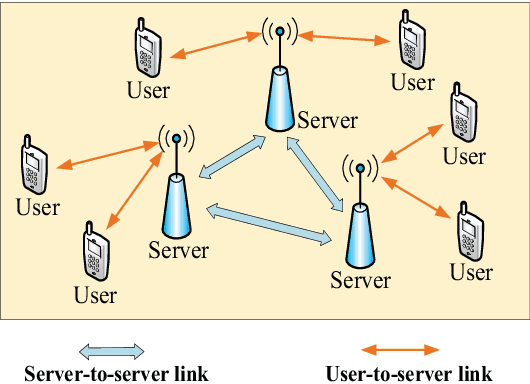
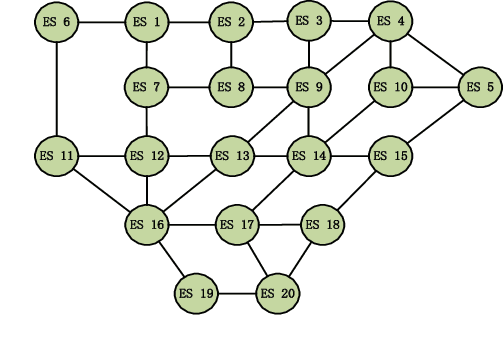
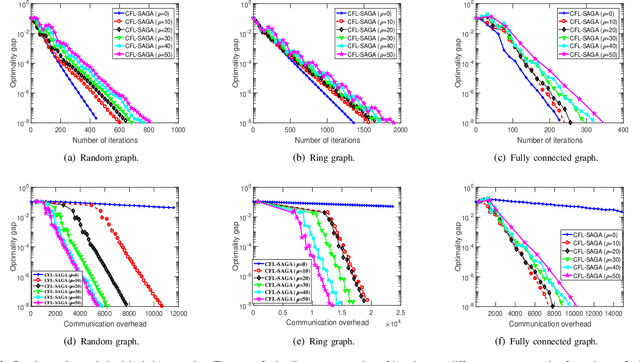

Abstract:Federated learning (FL) is a machine learning paradigm that targets model training without gathering the local data dispersed over various data sources. Standard FL, which employs a single server, can only support a limited number of users, leading to degraded learning capability. In this work, we consider a multi-server FL framework, referred to as \emph{Confederated Learning} (CFL), in order to accommodate a larger number of users. A CFL system is composed of multiple networked edge servers, with each server connected to an individual set of users. Decentralized collaboration among servers is leveraged to harness all users' data for model training. Due to the potentially massive number of users involved, it is crucial to reduce the communication overhead of the CFL system. We propose a stochastic gradient method for distributed learning in the CFL framework. The proposed method incorporates a conditionally-triggered user selection (CTUS) mechanism as the central component to effectively reduce communication overhead. Relying on a delicately designed triggering condition, the CTUS mechanism allows each server to select only a small number of users to upload their gradients, without significantly jeopardizing the convergence performance of the algorithm. Our theoretical analysis reveals that the proposed algorithm enjoys a linear convergence rate. Simulation results show that it achieves substantial improvement over state-of-the-art algorithms in terms of communication efficiency.
Generation Meets Verification: Accelerating Large Language Model Inference with Smart Parallel Auto-Correct Decoding
Feb 19, 2024



Abstract:This research aims to accelerate the inference speed of large language models (LLMs) with billions of parameters. We propose \textbf{S}mart \textbf{P}arallel \textbf{A}uto-\textbf{C}orrect d\textbf{E}coding (SPACE), an innovative approach designed for achieving lossless acceleration of LLMs. By integrating semi-autoregressive inference and speculative decoding capabilities, SPACE uniquely enables autoregressive LLMs to parallelize token generation and verification. This is realized through a specialized semi-autoregressive supervised fine-tuning process that equips existing LLMs with the ability to simultaneously predict multiple tokens. Additionally, an auto-correct decoding algorithm facilitates the simultaneous generation and verification of token sequences within a single model invocation. Through extensive experiments on a range of LLMs, SPACE has demonstrated inference speedup ranging from 2.7x-4.0x on HumanEval-X while maintaining output quality.
Joint Transceiver Optimization for MmWave/THz MU-MIMO ISAC Systems
Jan 31, 2024Abstract:In this paper, we consider the problem of joint transceiver design for millimeter wave (mmWave)/Terahertz (THz) multi-user MIMO integrated sensing and communication (ISAC) systems. Such a problem is formulated into a nonconvex optimization problem, with the objective of maximizing a weighted sum of communication users' rates and the passive radar's signal-to-clutter-and-noise-ratio (SCNR). By exploring a low-dimensional subspace property of the optimal precoder, a low-complexity block-coordinate-descent (BCD)-based algorithm is proposed. Our analysis reveals that the hybrid analog/digital beamforming structure can attain the same performance as that of a fully digital precoder, provided that the number of radio frequency (RF) chains is no less than the number of resolvable signal paths. Also, through expressing the precoder as a sum of a communication-precoder and a sensing-precoder, we develop an analytical solution to the joint transceiver design problem by generalizing the idea of block-diagonalization (BD) to the ISAC system. Simulation results show that with a proper tradeoff parameter, the proposed methods can achieve a decent compromise between communication and sensing, where the performance of each communication/sensing task experiences only a mild performance loss as compared with the performance attained by optimizing exclusively for a single task.
 Add to Chrome
Add to Chrome Add to Firefox
Add to Firefox Add to Edge
Add to Edge